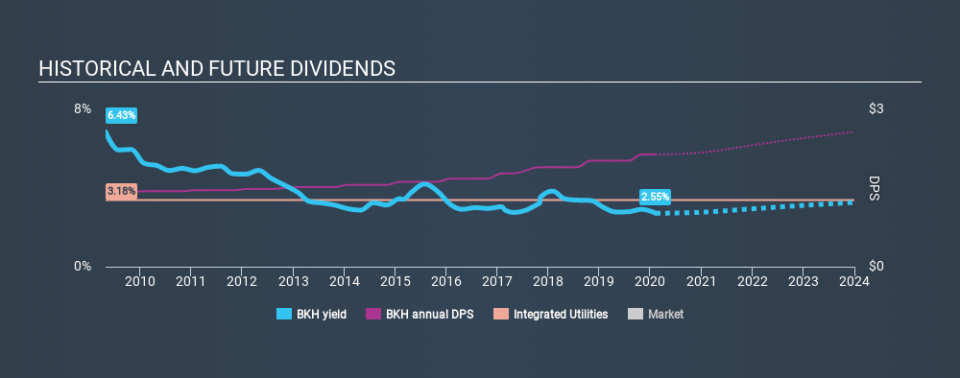Income Investors Should Know That Black Hills Corporation (NYSE:BKH) Goes Ex-Dividend Soon

Some investors rely on dividends for growing their wealth, and if you're one of those dividend sleuths, you might be intrigued to know that Black Hills Corporation (NYSE:BKH) is about to go ex-dividend in just 4 days. You can purchase shares before the 13th of February in order to receive the dividend, which the company will pay on the 1st of March.
Black Hills's upcoming dividend is US$0.54 a share, following on from the last 12 months, when the company distributed a total of US$2.14 per share to shareholders. Last year's total dividend payments show that Black Hills has a trailing yield of 2.6% on the current share price of $83.91. Dividends are a major contributor to investment returns for long term holders, but only if the dividend continues to be paid. So we need to check whether the dividend payments are covered, and if earnings are growing.
Check out our latest analysis for Black Hills
If a company pays out more in dividends than it earned, then the dividend might become unsustainable - hardly an ideal situation. Black Hills paid out 61% of its earnings to investors last year, a normal payout level for most businesses. Black Hills paid a dividend despite reporting negative free cash flow last year. That's typically a bad combination and - if this were more than a one-off - not sustainable.
Click here to see the company's payout ratio, plus analyst estimates of its future dividends.
Have Earnings And Dividends Been Growing?
Companies with consistently growing earnings per share generally make the best dividend stocks, as they usually find it easier to grow dividends per share. Investors love dividends, so if earnings fall and the dividend is reduced, expect a stock to be sold off heavily at the same time. With that in mind, we're encouraged by the steady growth at Black Hills, with earnings per share up 2.2% on average over the last five years.
We'd also point out that Black Hills issued a meaningful number of new shares in the past year. Trying to grow the dividend while issuing large amounts of new shares reminds us of the ancient Greek tale of Sisyphus - perpetually pushing a boulder uphill.
Another key way to measure a company's dividend prospects is by measuring its historical rate of dividend growth. Since the start of our data, ten years ago, Black Hills has lifted its dividend by approximately 4.2% a year on average. It's encouraging to see the company lifting dividends while earnings are growing, suggesting at least some corporate interest in rewarding shareholders.
The Bottom Line
From a dividend perspective, should investors buy or avoid Black Hills? Black Hills has been generating some growth in earnings per share while paying out more than half of its earnings to shareholders in the form of dividends. Overall, Black Hills looks like a promising dividend stock in this analysis, and we think it would be worth investigating further.
Ever wonder what the future holds for Black Hills? See what the five analysts we track are forecasting, with this visualisation of its historical and future estimated earnings and cash flow
We wouldn't recommend just buying the first dividend stock you see, though. Here's a list of interesting dividend stocks with a greater than 2% yield and an upcoming dividend.
If you spot an error that warrants correction, please contact the editor at editorial-team@simplywallst.com. This article by Simply Wall St is general in nature. It does not constitute a recommendation to buy or sell any stock, and does not take account of your objectives, or your financial situation. Simply Wall St has no position in the stocks mentioned.
We aim to bring you long-term focused research analysis driven by fundamental data. Note that our analysis may not factor in the latest price-sensitive company announcements or qualitative material. Thank you for reading.

 Yahoo Finance
Yahoo Finance 
